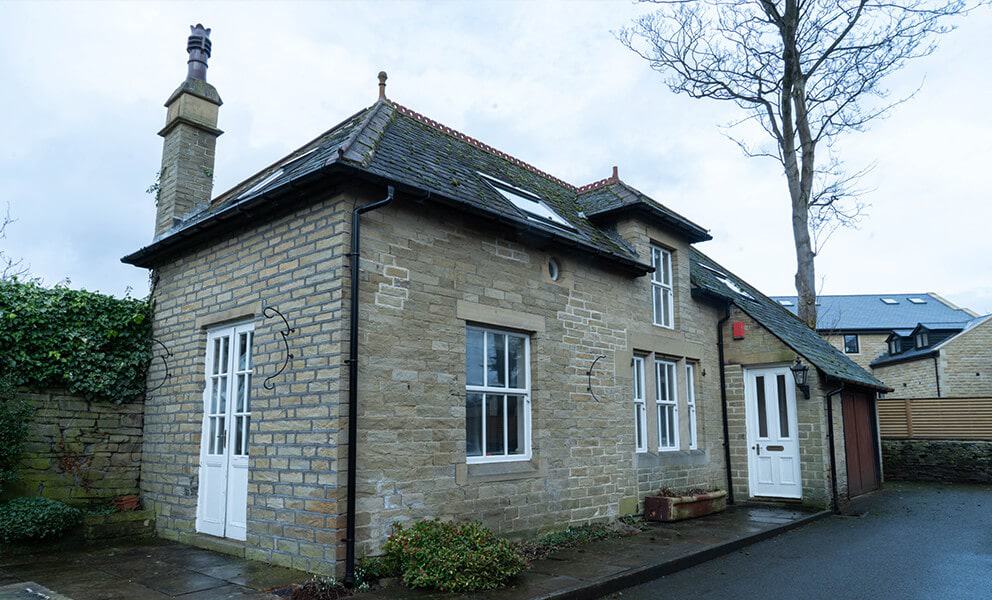
Call our team
01484 442420Find An Applicator
Menu
close

Armed with the latest U-value testing equipment, and excited by the improved thermal performance data shown by the next generation SprayCork material in the lab, we set out to assess the product’s thermal insulation performance as a Thin Internal Wall Insulation in a real life situation.The background to the testing was the UK Government’s March 2021 report on Thin Internal Wall Insulation (TIWI), which highlighted the potentially very large nationwide benefits for both energy efficiency and fuel poverty from high performance TIWI systems.
The chosen test property was a 1890’s solid walled Yorkshire stone detached cottage in Halifax. This rental property was between tenancies, and with a compliant landlord, we had a great chance to capture real world data.
The landlord had experienced problems with penetrating damp in the gable wall, so had repointed this wall externally a year previously. Knowing that this wall was now fully dry, it made for a great test wall. We determined the exact mounting point for the test rig using IR camera images to avoid those cold bridge dabs which might skew the test.
The small gas boiler struggled to keep the property warm in winter and there was mould and damp evident on the walls, primarily in the corners and around the reveals of the French doors and windows. By drilling into the walls we confirmed that there was no existing insulation, just plasterboard dot and dab fixed direct to the 300mm thick stone. The large dabs holding the plasterboard in place were cold to the touch, and the IR camera confirmed clearly that they were acting as a strong cold bridge.
The U-value test kit used, an ISO 9869-1:2014 approved Swiss system, requires three measurements - internal temperature, external temperature and heat flux - to be recorded every minute for at least 72 hours. The test requires internal and external temperatures to be significantly different, so the fact that we were running the test in winter and had control over the central heating system helped.
The wall was tested before application of SprayCork, and a U-value of 1.58W/mK was obtained. This is a reasonably good performance for an uninsulated stone wall, but well within the expected range.
SprayCork was spray applied seamlessly direct to the existing plasterboard, across the whole internal surface of the exterior walls and around the window reveals. Application was in two layers giving an overall depth of 5-6mm. After drying, the walls were skimmed with 2mm of standard gypsum plaster, all in the same day.
Immediately there were signs that there were significant improvements in thermal performance. IR images showed a visible reduction in the cold bridges which had been caused by the plaster dabs and around the internal corners. This was visual confirmation of SprayCork’s effectiveness at increasing the surface temperature of the treated walls and so controlling condensation and mould.
After application, the U-value testing kit was remounted in the same spot as for the first test, under the same conditions. Four days later, the test was complete to ISO9867 standard, and the resulting U-value had improved to 1.10W/mK.
By improving U-value from 1.58 to 1.10, the SprayCork had caused a 30.4% reduction in heat loss through the wall.
This is an incredible result for a product applied at only 6mm thick, and is testament to the wonderful natural properties of cork, the world’s finest natural insulator.
By improving U-value from 1.58 to 1.10, the SprayCork had caused a 30.4% reduction in heat l The result represents a significant improvement over the thermal performance of the first generation of sprayed cork, largely due to the increased concentration of cork granules in the new product. The additional improvements in condensation and mould control, along with creating a cosier feel for occupants, all driven by the increase in internal wall surface temperature, make for a compelling package of benefits.
The thin layer at which the product is applied makes it perfect for:
The breathable, vapour-open nature of SprayCork makes it an ideal solution for traditional, solid walled properties whose walls were designed to breathe. This sector of the UK built environment comprises almost all homes built before 1930, totalling 7.8 million, and of which less than 10% have any form of wall insulation. The SprayCork solution allows traditional buildings to continue to operate as designed, minimising the chances of unintended consequences of installation, and making a significant impact on the UK’s journey towards Net Zero carbon by 2050.
"*" indicates required fields